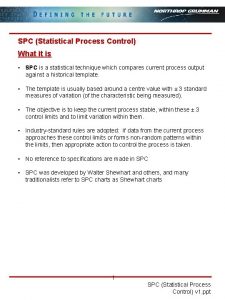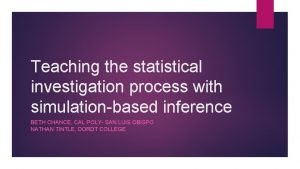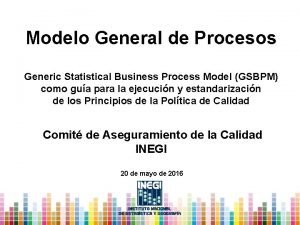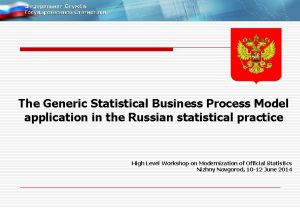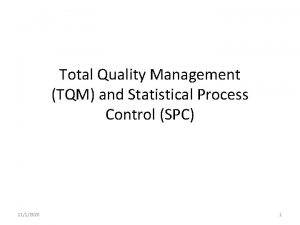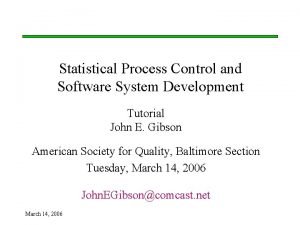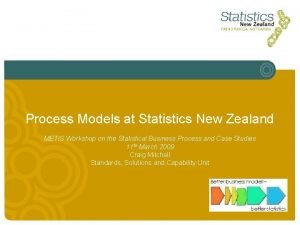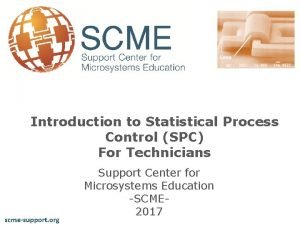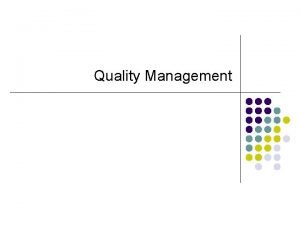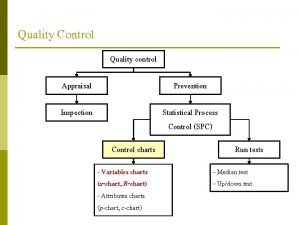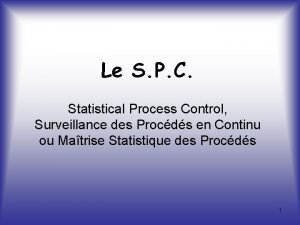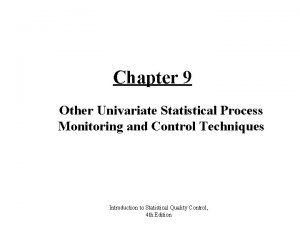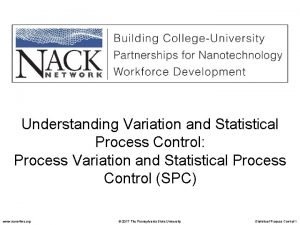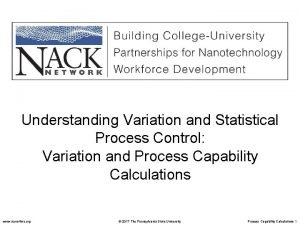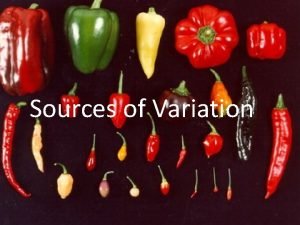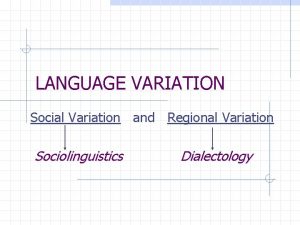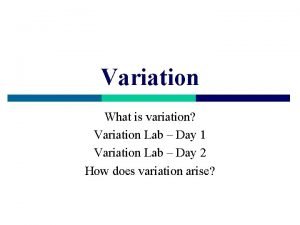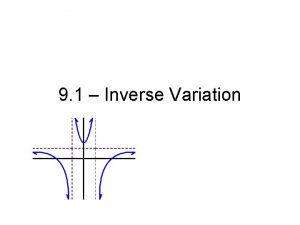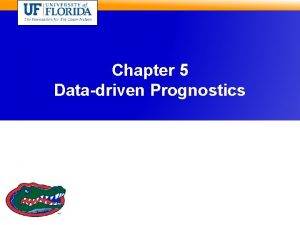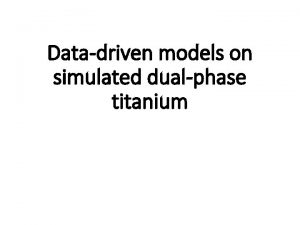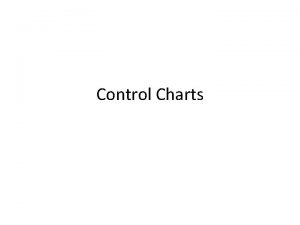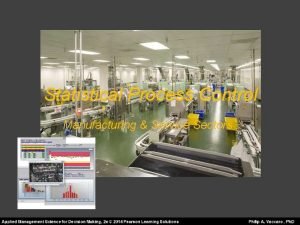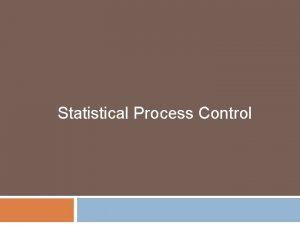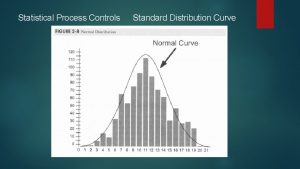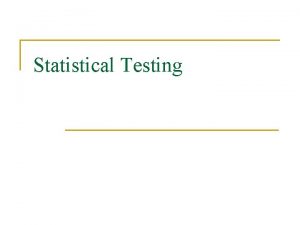A DataDriven Statistical Approach to Analyzing Process Variation





















- Slides: 21

A Data-Driven Statistical Approach to Analyzing Process Variation in 65 nm SOI Technology ISQED 2007, San Jose, Mar 28, 2007 Choongyeun Cho 1, Daeik Kim 1, Jonghae Kim 1, Jean-Olivier Plouchart 1, Daihyun Lim 2, Sangyeun Cho 3, and Robert Trzcinski 1 Cho et al. 1 IBM, 2 MIT, 3 U. of Pittsburgh ISQED 2007

Outline § Introduction: § Motivation of this work § Constrained Principal Component Analysis § Proposed method § Experiments: § Using 65 nm SOI technology § Conclusion § Applications, future work § Contributions Cho et al. ISQED 2007 2

Motivation § Process variation (PV) limits performance/yield of an IC. § PV is hard to model or predict. § Many factors of different nature contribute to PV. § Physical modeling is intractable. § Four ranges of PV: Within-die Cho et al. Die-to-Die Wafer-to-Wafer Lot-to-Lot ISQED 2007 3

Motivation § We present an efficient method to decompose PV into D 2 D and W 2 W components. § Use existing manufacturing “in-line” data only. § No model! Within-die Cho et al. Die-to-Die Wafer-to-Wafer Lot-to-Lot ISQED 2007 4

What is In-line Data? § In this work, “in-line” data refers to: § Electrical measurements in manufacturing line using a parametric tester for various purposes: fault diagnosis, device dc characterization, and model-hardware correlation (MHC). § Thus, available very early in the manufacturing process. § Key PV parameters (VT, LPOLY, TOX, etc) are mostly embedded in in-line data yet in an obscure manner. § We statistically exploit in-line data to extract D 2 D and W 2 W variations individually. Cho et al. ISQED 2007 5

Principal Component Analysis § Principal Component Analysis (PCA) rotates coordinates such that resulting vectors are: § Uncorrelated, § Ordered in terms of variance. § Can= be defined recursively: T w 1 arg max var (w x) w k = arg jjw jj= 1 max j j w j j = 1; w ? w i 8 i = 1; : : : ; k ¡ 1 var (w T x); k ¸ 2 where x is an original vect or and w i is i -t h PC. Cho et al. ISQED 2007 6

Constrained PCA § Constrained PCA (CPCA): same as PCA except PC’s are constrained to a predefined subspace. § In this work, constraint is that a PC must align with D 2 D or W 2 W variation direction. Ordinary PCA Cho et al. Proposed CPCA ISQED 2007 7

Proposed Algorithm In-line data Standardization Screening Find first PC for D 2 D variation Find first PC for W 2 W variation § Can generalize for within-die and lotto-lot variations. § Implemented with <100 lines of Matlab code. Take PC with larger variance Subtract this PC space from original data Cho et al. ISQED 2007 8

Case I: 65 nm SOI Tech § 65 nm SOI CMOS data (300 mm wafer) § 1109 in-line parameters used: Type FET RO # Param’s 759 83 SRAM Capacitance Total 159 108 1109 § 40 dies/wafer, 13 wafers = 520 samples. § The run for whole data was <1 min on an ordinary PC. Cho et al. ISQED 2007 9

Cumulative variance explained Case I: 65 nm SOI Tech PCA 0. 8 0. 7 Constrained PCA 0. 6 Type Variance explained Cumulative Variance explained 1 Die 31. 0% 0. 4 2 Wafer 25. 2% 56. 2% 3 Die 4. 5% 60. 7% 0. 3 4 Wafer 4. 2% 64. 9% 5 Wafer 2. 4% 67. 3% 0. 5 0. 2 Cho et al. 1 5 CPC Index 10 PC/CPC Index 15 20 ISQED 2007 10

Case I: 65 nm SOI Tech D 2 D variation (1 st CPC) W 2 W variations (Fitted with 2 nd order polynomials on the 40 available samples) (2 nd, 4 th, 5 th CPC’s) Cho et al. ISQED 2007 11

Case II: Applied to RF Circuit Bench-tested RF self-oscillation frequencies (Fosc) for static CML frequency divider. 45 Fosc 40 35 30 25 40 Die Cho et al. 10 20 ind Site ex 5 0 0 Original e d n i Wafer er f a W x ISQED 2007 12

Reconstruction 1 45 Fosc 40 35 30 25 40 Die Cho et al. 10 20 ind Site ex 5 0 0 Offset e d n i Wafer er f a W x ISQED 2007 13

Reconstruction 2 45 Fosc 40 35 30 25 40 Die Cho et al. 10 20 ind Site ex 5 0 0 e d n i Wafer er f a W Offset + CPC#1 (D 2 D) x ISQED 2007 14

Reconstruction 3 45 Fosc 40 35 30 25 40 Die Cho et al. 10 20 ind Site ex 5 0 0 e d n i Wafer er f a W x Offset + CPC#1 + CPC#2 (W 2 W) ISQED 2007 15

Reconstruction 4 45 Fosc 40 35 30 25 40 Die Cho et al. 10 20 ind Site ex 5 0 0 e d n i Wafer er f a W x Offset + CPC#1 + CPC#2 + CPC#3 (D 2 D) ISQED 2007 16

Reconstruction 5 45 Fosc 40 35 30 25 40 Die Cho et al. 10 20 ind Site ex 5 0 0 e d n i Wafer er f a W x Offset + CPC#1 + CPC#2 + CPC#3 + CPC#4 (W 2 W) ISQED 2007 17

Reconstruction & Original § PVs obtained from in-line measurement explain significant portion (66%) of PV existing in complex RF circuit. 45 Fosc 40 35 30 25 40 Die Cho et al. 10 20 ind Site ex 5 0 0 e d n i Wafer er f a W x ISQED 2007 18

Case III: Technology Monitoring § Dominant D 2 D variations obtained for three successive 65 nm SOI tech iterations. § Visualize how technology stabilizes. Iteration 1 (Preproduction) Cho et al. Iteration 2 Iteration 3 ISQED 2007 19

Application / Future Work § Intelligent sampling: D 2 D variation signature may serve as a guideline to pick representative chips for sampled tests. § Technology snapshot: Use D 2 D variation to monitor characteristic of a given lot or technology. § Future work includes: § Incorporate within-die and lot-to-lot variations. § Statistical elaboration (Non-Gaussianity, etc). Cho et al. ISQED 2007 20

Contributions § Presented a statistical method to separate die-to-die and wafer-to-wafer variations using PCA variant: § Allows visualization and analysis of systematic variations. § Rapid feedback to tech development. § Verified that RF circuit performance is tied to device PV’s. Cho et al. ISQED 2007 21
 Datadriven marketing
Datadriven marketing Direct variation constant of variation
Direct variation constant of variation Inverse eq
Inverse eq Correlation and regression
Correlation and regression Statistical process control ppt
Statistical process control ppt Statistical investigation process
Statistical investigation process Generic statistical business process model
Generic statistical business process model Uiiss
Uiiss Grandfather of tqm
Grandfather of tqm Statistical process control tutorial
Statistical process control tutorial Promotions o'cool
Promotions o'cool Control chart variation
Control chart variation Quality
Quality เฉล
เฉล Statistical process control definition
Statistical process control definition Statistical process control
Statistical process control Difference between datagram and virtual circuit operation
Difference between datagram and virtual circuit operation Cognitive approach vs behavioral approach
Cognitive approach vs behavioral approach What is preliminary and fine grain screening?
What is preliminary and fine grain screening? Multiple conflict
Multiple conflict Cognitive approach vs behavioral approach
Cognitive approach vs behavioral approach Approach approach
Approach approach




